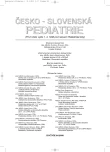Recent Trends in Diagnosis of Fetal Alcohol Syndrome
Authors:
J. B. Novotný 1; Z. Novotný 2
Authors‘ workplace:
Institut mezioborových studií, Brno
vedoucí ing. M. Bargel, CSc.
1; Dětský domov pro děti do 3 let, p. o., Ostrava
vedoucí MUDr. Z. Novotný
2
Published in:
Čes-slov Pediat 2009; 64 (5): 251-256.
Category:
Review Article
Overview
Fetal Alcohol Syndrome is a complex of syndromes, occurring at fetus exposed prenatally to alcohol. It belongs to wider group of FASD, where belong also ARBD, ARND and PFAS1.
Diagnostics of FAS in this country is underrated. It comes out mostly merely from presence of facial abnormalities (so the statistical and diagnostic entries in this field are very probably greatly underrated).
The need of systematic approach to diagnosis of Fetal Alcohol Syndrome (FAS) led to formation of some complex diagnostic tools. The fundamental scheme was outlined in 1996 by Institute of Medicine Diagnostic Guide. Regrettably this tool suffered from strong non-specificity of diagnostic criteria.
As a reaction to this critique, “Diagnostic Guide for Fetal Alcohol Spectrum Disorders – The 4-Digit Diagnostic Code” (4DDC) was developed. This systematic and categorically conceived tool is a complex guide through FAS diagnosis and offers clean-cut borders and criteria. By that it becomes a basis for further guidelines. The only disadvantage of this guide is the length of administration, the advantage is a detailed diagnosis, enabling and proposing consequent treatment.
American Centers for Disease Control and Prevention (CDC) published their own material “Fetal Alcohol Syndrome: Guidelines for Referral and Diagnosis”. In comparison to 4DDC this tool is written in a more narrative way. Anyhow it avoids IOM Guide’s non-specificity and defines clearly the diagnostic criteria. It also offers details for FAS differential diagnosis.
Last tool is “Canadian Guidelines for FASD Diagnosis”. They stem largely from 4DDC and represent more or less abbreviated and “simplified” form of diagnostic guidelines.
The range of available tools, available for FAS diagnosis, is presently relatively wide. The first necessary step is however an increased specialists’ concern about prenatal alcohol exposure questions and an attempt to work systematically in this field.
There are also screening tools of risk drinking during pregnancy. Mostly expanded are for instance TWEAK questionnaires. Their benefits are especially quick and easy administration and evaluation.
Other possible way is to examine biological markers of alcohol in mother’s and child’s body. Mother’s markers are however affected by other possible reasons so they have minor predicative value. Actually promising method is the examination of Fatty Acid Ethyl Esters (FAEEs) in meconium and hair samples of the child. Researches confirmed connection between concrete FAEEs levels and typical problems, paired with prenatal alcohol exposure. Samples’ developmental aspect is the only limitation, because they can tell us information only from second and third trimester.
Key words:
fetal alcohol syndrome (FAS), FAS diagnosis, screening tools, biological markers, complex diagnostic tools
Sources
1. Zima T. Fetální alkoholový syndrom. Protialkoholní Obzor 1994;29(1): 7–14.
2. Knappen B, Thater H, Löser H. Ratgeber zur Alkoholembryopathie: Alkoholschäden bei Kindern. Freiburg: Lambertus Verlag, 1987.
3. Astley SJ, Bailey D, Talbot Ch, Clarren SK. Fetal alcohol syndrome (FAS) primary prevention through FAS diagnosis: I. Identification of high-risk birth mothers through the diagnosis of their child. Alcohol and Alcoholism 2000;35(5): 499–508.
4. Nešpor K, Csémy L. Alkohol v těhotenství. Čas. Lék. čes. 2005;144(10): 704–705.
5. Dryden J, et al. Researchers identify damage mechanism in fetal alcohol syndrome. In Ikonomidou C, et al (ed.) Ethanol-Induced Apoptotic Neurodegeneration and the Fetal Alcohol Syndrome. Science, 2000: 1–287.
6. Jones KL, Chambers CD, Hill LL, et al. Alcohol use in pregnancy: inadequate recommendations for an increasing problem. Commentary. BJOG 2006;113(8): 967–968.
7. Institute of Medicine. Fetal Alcohol Syndrome: Diagnosis, Epidemiology, Prevention, and Treatment. Washington D.C.: National Academy Press, 1996.
8. Avner M, Nulman I. Attempts at more specific and practical diagnostic criteria for fetal alcohol spectrum disorders. JFAS Int. 2005;3: e12.
9. Astley SJ. Diagnostic Guide for Fetal Alcohol Spectrum Disorders: The 4-Digit Diagnostic Code. 3rd ed. Seattle: University of Washington Publication Services, 2004.
10. NCBDDD/CDC. Fetal Alcohol Syndrome: Guidelines for Referral and Diagnosis. NTF FAS/FAE, 2004.
11. Chudley AE, Conry J, Cook JL, et al. Fetal alcohol spektrum disorders: Canadian guidelines for diagnosis. CMAJ 2005;172(Suppl. 5).
12. Chang G, Wilkind-Haug L, Berman S, et al. Alcohol use and pregnancy: Improving identification. Obstetrics and Gynecology 1998;91: 892–898.
13. Čech E, Hájek Z, et al. Porodnictví. 2. vyd. Praha: Grada, 2006.
14. Stoler JM, Huntington KS, Petersen CM, Daniel P, et al. The prenatal detection of significant alcohol exposure with maternal blood markers. J. Pediatr. 1998;133(3): 346–352.
15. Koren G, Nulman I, Chudley AE, Loocke Ch. Fetal alcohol spectrum disorders. CMAJ 2003;169(11): 1181–1185.
16. Pragst F, Auwaerter V, Sporkert F, Spiegel K. Analysis of fatty acid ethyl esters in hair as possible markers of chronically elevated alcohol consumption by headspace solid-phase microextraction (HS-SPME) and gas chromatography-mass spectrometry (GC-MS). Forensic. Sci. Int. 2001;121(1–2): 76–88.
17. Moore Ch, Jones J, Lewis D, Buchi K. Prevalence of fatty acid ethyl esters in meconium specimens. Clinical Chemistry 2003;49(1): 133–136.
18. Jacobson SW, et al. Meconium fatty acid ethyl esters (FAEEs) as predictors of severity of fetal alcohol spectrum disorder. Alcohol Clin. Exp. Res. 2006;30(6): S175.
19. Noland JS, et al. Prenatal drug exposure and selective attention in preschoolers. Neurotoxicol. Teratol. 2005;27(3): 429–438.
20. Derauf C, Katz AR, Frank DA, Grandinetti A, Easa D. The prevalence of ethamphetamine and other drug use during pregnancy in Hawaii. Journal of Drug Issues 2003;33(4): 1001–1016.
Labels
Neonatology Paediatrics General practitioner for children and adolescentsArticle was published in
Czech-Slovak Pediatrics

2009 Issue 5
Most read in this issue
- Recent Trends in Diagnosis of Fetal Alcohol Syndrome
- Acute Neuroborrelioses in Children
- Molecular Diagnostics of Hereditary Unconjugated Hyperbilirubinemias in Slovakia
- Standards of the Multidisciplinary Treatment of a Child with Orofacial Cleft
